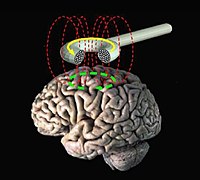
Photo from wikipedia
Image‐guided repetitive transcranial magnetic stimulation (rTMS) has shown clinical effectiveness in senior adults with co‐occurring depression and cognitive impairment, yet the imaging markers for predicting the treatment response are less… Click to show full abstract
Image‐guided repetitive transcranial magnetic stimulation (rTMS) has shown clinical effectiveness in senior adults with co‐occurring depression and cognitive impairment, yet the imaging markers for predicting the treatment response are less investigated. In this clinical trial, we examined the efficacy and sustainability of 10 Hz rTMS for the treatment of depression and cognitive impairment in major neurocognitive disorder (NCD) patients and tested the predictive values of imaging‐informed radiomic features in response to rTMS treatment. Fifty‐five major NCD patients with depression were randomly assigned to receive a 3‐week rTMS treatment of either active 10 Hz rTMS (n = 27) or sham rTMS (n = 28). Left dorsolateral prefrontal cortex (DLPFC) was the predefined treatment target. Based on individual structural magnetic resonance imaging scans, surface‐based analysis was conducted to quantitatively measure the baseline radiomic features of left DLPFC. Severity of depression, global cognition and the serum brain‐derived neurotrophic factor (BDNF) level were evaluated at baseline, 3‐, 6‐ and 12‐week follow‐ups. Logistic regression analysis revealed that advanced age, higher baseline cognition and randomized group were associated with the remission of depression. Increased cortical thickness and gyrification in left DLPFC were the significant predictors of clinical remission and cognitive enhancement. A 3‐week course of 10 Hz rTMS is an effective adjuvant treatment for rapid ameliorating depressive symptoms and enhancing cognitive function. Pre‐treatment radiomic features of the stimulation target can predict the response to rTMS treatment in major NCD. Cortical thickness and folding of treatment target may serve as imaging markers to detect the responders. ChiCTR‐IOR‐16008191, registered on March 30, 2016.
Journal Title: Human Brain Mapping
Year Published: 2022
Link to full text (if available)
Share on Social Media: Sign Up to like & get
recommendations!